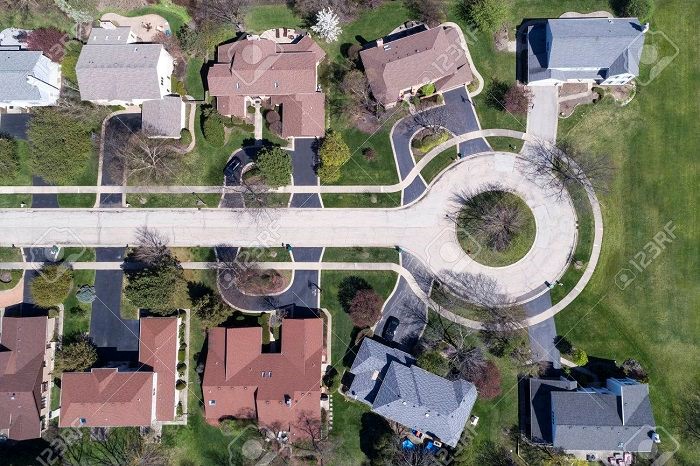
Cul-De-Sacs are dead end streets. They are most commonly seen in American and European suburbs where piles of houses of similar forms and shapes are built together. Cul-De-Sacs were constructed to stop traffic and so that each house in the suburb is spacious for the cars to pass through. It was a way to stop sporadic growth of traffic in the suburbs or even within the city where dead end streets stop passage of vehicles. Cul-De-Sacs are part of a grid plan city structure which was formed in 1970s in the USA and UK. It can be aligned to a one way traffic, although it blocks the traffic at the end of the street and usually has a curve with circular motion.
Aerial view of homes on a cul-de-sac in a suburban setting in the Chicago area.
In the suburbs, the Cul-De-Sac streets are divided into one or several central roads in the subdivision of streets of different sizes connecting from the main roads in order to subdivide the land. Early urban planners had suggested that there were many positive features in the Cul-De-Sac, particularly in residential areas, where the grid pattern stops traffic from crowding, reduces noise and helps prevent air pollution. There is also substantial prevention of accidents in the Cul-De-Sac areas because there are no vehicles constantly driving towards each other. However, this perception has significantly changed since the previous generations.
Related: Latest technology trends in urban planning, Urban Planning – A largely unknown profession

History of the Cul-De-Sac
Dead end streets have been part of the world since 15th Century or even during earlier periods. It was a technique used to prevent civil wars and security against wars for passage of military vehicles during the early ancient periods. However, as a city planning legislation, Cul-De-Sacs were first legalised in England with the Hampstead Garden Suburb Act in 1906. This type of planning was thought to be ideal in suburbs with gardens as they provided more peaceful flow of traffic and low congestion rates. The 1906 Act did not allow vehicles to pass through the cul-de-sac as they had to drive around it, and had a maximum length of 500 feet. The Hampstead Garden Suburb Act was influential for all the Garden Cities of England including the famous Welwyn Garden City by Ebenezer Howard.
The dead end streets grew into popularity in the 19th and 20th Centuries, with many suburbs being constructed in the developed countries such as USA, Europe, Australia and New Zealand to name a few. People preferred to live in their own large sized houses away from the city center, in residential suburbs, as they wanted to have more space for a family-type living arrangement. This was a consequence of motor vehicles and the popularity of car-driven vehicles. Cul-De-Sacs were seen as a mark to suggest that unlike the central city, suburbs were not spaces where cars could easily pass through.
The different perspectives of Cul-De-Sacs
Although Cul-De-Sacs were seen as being promising in the previous years, they are increasingly being thought as ‘bad urban planning’ and seen to be negative in 21st Century. This is because inner city living is seen as more promising. Urban density which has increased significantly throughout the generations has given an impression that high density with low spaces such as apartment complexes promote better urban planning such as in New York City and London which are increasingly catering to high density populations.
Planning that promotes density is thought of as good urban planning, whereas suburbs promote low density and a low population with greater room space per person. It is still considered by some suburbs as promising to have Cul-De-Sacs as they prevent noise and flow of traffic. One of the main negative aspects of a Cul-De-Sac is that it does not provide the same density as a grid plan does. As cul-de-sacs are one way traffic movements, they create complicated car centric traffic flows. They promote more circuitous routes to reach the final destination.
Related: Traffic Islands, Road Intersection & Its Types
In today’s 21st century, there is a mix of suburban cul-de-sacs along with high density living in the inner cities. It is said that millenniums prefer to live in the inner cities because of the convenience to all the city based facilities. As the number of people living alone and without the traditional type of family is also increasing, Cul-De-Sacs are not looked upon as promising because suburban lifestyle is vastly decreasing. However, that said, many cities around the world still have Cul-De-Sac streets and are making use of it even with the negative feedback from urban planners. Many early urban planners, have promoted Cul-De-Sac but the perspective is largely changing in today’s world and it depends on which country the urban planner is based at along with individual preference.
Therefore, whether Cul-De-Sac are ‘good’ urban planning or ‘bad’ urban planning, largely depends on where you want to live and what type of density arrangement you want to be in.
Thejas Jagannath | June 29, 2019 at 1:11 pm | URL: https://wp.me/p68gLH-2W6
